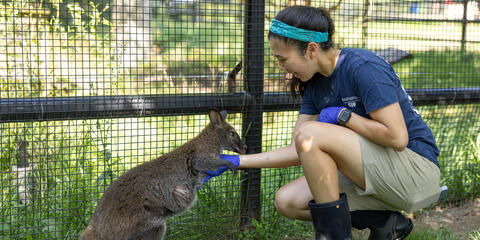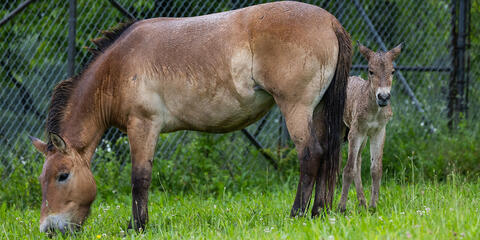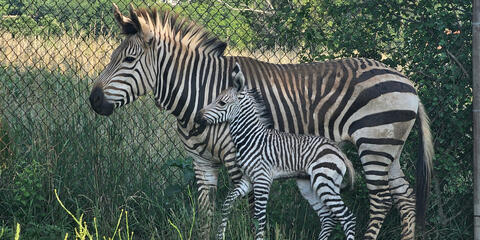Physical Description
Striped skunks have an easily identifiable coloration: two thick white stripes along the back and tail sharply contrast an otherwise black coat. The specific pattern of the stripes on the head, body and tail can vary among individuals, and is accompanied by a thin, white stripe running from the snout to forehead.
Size
Striped skunk sizes vary greatly depending upon time of year and geographic location, with weights fluctuating between 1.5 and 13 pounds (0.7 to 6.3 kg), and total length varying between 18 and 32 inches (46.5 to 81.5 cm). There is a significant reduction in body mass during winter months, when striped skunks can lose up to 50 percent of their weight. Males are typically slightly larger than females.
Native Habitat
Striped skunks live throughout North America from southern Canada into northern Mexico.
The most common skunks in North America, striped skunks are terrestrial animals that can survive in a variety of habitats and land types. They prefer open areas, with abundant populations observed on agricultural lands. They have been observed living in wooded areas, deserts and plains, and have even adapted to urban and suburban environments. Striped skunks are typically found at elevations below 5,900 feet (1,800 meters).
Lifespan
The average lifespan of striped skunks in the wild is 7 years. They can live up to 10 years in human care.
Communication
Spraying an offending creature typically occurs after a warning display, which involves the skunk stomping its feet and arching its back while raising its tail.
Food/Eating Habits
Striped skunks are omnivorous, opportunistic feeders. Their diet is primarily insectivorous during the spring and summer seasons when grasshoppers, beetles, crickets, bees and other arthropods are abundant, then switches to a carnivorous diet during colder months.
Throughout the winter, they have been observed eating small mammals and ground-nesting hatchlings and eggs, and hunting amphibians, reptiles and fish. Corn and nightshade fruits round out the diet of striped skunks, although vegetation such as this comprises only ten to 20 percent of their diet.
Striped skunks at the Smithsonian's National Zoo consume a diet consisting primarily of leafy greens, vegetables and insects. They occasionally receive mice, eggs, nuts and select fruits as well.
Sleep Habits
Skunks are nocturnal.
Social Structure
Striped skunks are solitary, typically docile animals. They often live in the abandoned dens of other mammals during the day, or take up residence in hollowed logs, brush piles or underneath buildings. They prefer underground dens in colder winter climates. While not truly hibernating, striped skunks experience extended periods of inactivity during winter.
Reproduction and Development
Male striped skunks breed with multiple females, and are rejected by the females after mating occurs. Female striped skunks typically give birth once each year, with breeding occurring between February and April.
In some cases, a secondary breeding period will occur in May in the event that the first litter was lost, or pseudopregnacny occurs. Striped skunks can experience delayed implantation lasting up to 19 days. After a gestation period of 59 to 77 days, a litter of two to ten skunks is born. Young, called kits or kittens, are born helpless, with eyes opening at about 3 weeks and weaning occurring at 6 to 7 weeks.
Once they are weaned, the young skunks will follow their mother in a single file line and learn to forage and hunt. There is a high mortality rate among skunks; many do not survive beyond their first year. Young striped skunks reach sexual maturity at about 10 months.
Conservation Efforts
Threats to striped skunks include severe weather, naturally occurring predation and disease, exposure to chemicals and other human activities. Rabies outbreaks have affected populations in Illinois. Additionally, most states permit skunk harvesting year-round.
Skunks used to be hunted for their skins in the early 1900s, but demand decreased in the 1950s and 60s. Some harvesting continues today.
Help this Species
- Reduce, reuse and recycle — in that order! Cut back on single-use goods, and find creative ways to reuse products at the end of their life cycle. Choose recycling over trash when possible.
- Avoid single-use plastics, such as plastic bottles, bags and utensils. Choosing reusable options instead can help reduce plastic pollution.
- Protect local waterways by using fewer pesticides when caring for your garden or lawn. Using fertilizers sparingly, keeping storm drains free of litter and picking up after your pet can also improve watershed health.



